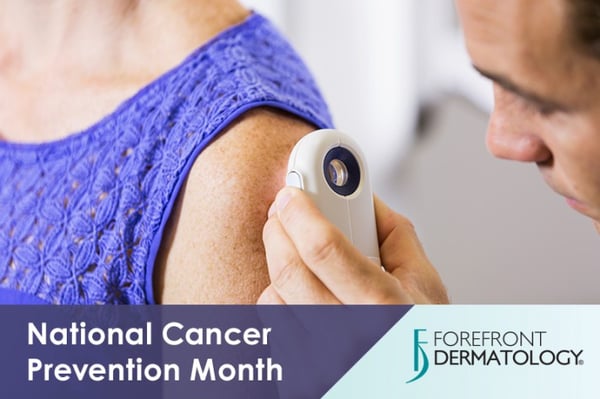
You can call it every expletive known to man or make any number of rude gestures in its general direction, but the fact remains that cancer is a terrible, horrible, no-good, very bad thing. It’s scary, physically damaging, emotionally draining, potentially deadly, and, unfortunately, incredibly common. Although skin cancer is the most commonly diagnosed form of cancer, with more than 3 million diagnoses each year, it’s also one of the most easily treatable and preventable. In fact, the largest share of skin cancer diagnoses comes in the form of Basal cell and Squamous cell cancers – both relatively non-aggressive and offering good outcomes when found and treated. Even melanoma, by far the most serious form of skin cancer, can be treated when found in its early stages. In honor of National Cancer Prevention Month, Forefront Dermatology wants to help you live a longer, healthier life with these skin cancer prevention and early detection tips. Know Common Risk Factors Sun-worshippers beware! Because Melanoma starts in melanocytes, the skin cells that release pigment in order to protect the delicate deeper layers from the sun’s radiation (also known as that golden goddess suntan), the biggest risk factor is UV exposure. Other factors include complexion (fair skin that won’t tan or burns easily increases your risk for skin cancers), family history of skin cancers, moles, weakened or compromised immune system, smoking, and aging. Individuals who have successfully been treated for skin cancer in the past are at greater risk of developing new cancerous growths – for Basal cell and Squamous cell carcinoma, the risk of getting a new skin cancer is about 50 percent, while Melanoma is 12-14 percent. Protect Yourself from Harmful Radiation While some factors – like family history, aging, and compromised immune system – can’t be mitigated, you are in control of your UV exposure. Daily sunscreen use helps prevent harmful UV damage, while still allowing enough exposure to produce Vitamin D, an important part of musculoskeletal health. While using a daily moisturizer with sunscreen is a good habit, be sure to switch to a heavier, longer-lasting sunscreen of SPF 30 or greater, if you expect to be out in direct sunlight for an extended period of time. Skin Screening Saves Lives Regular self-examinations are the best way to catch skin abnormalities at their most treatable stages. So grab a mirror and get ready to become intimately familiar with every inch of your skin. From head to toe – and every nook and cranny in between – evaluate each spot for its ABCDE’s. Asymmetry – If you draw a line through the middle of the benign mole, the two halves should roughly match. If not, it may be a sign of melanoma. Borders – The edges of a benign mole are smooth and even. Scalloped, rough, or notched edges are indicative of early stage melanoma. Color – Most benign moles are fairly even colored. Melanoma may be multiple shades of brown, black, red, white, or even blue. Diameter – Benign moles are typically smaller than malignant ones. If its diameter is greater than a pencil eraser, it may be a sign that it is growing or changing. Larger moles that have been stable for an extended period of time aren’t typically cause for concern; though continued observation is recommended. Evolution – Part of the reason regular self-screenings are effective is because you’ll more easily notice when moles grow in size, shape, or color – indicating Melanoma. Should you come across any moles that meet any of the ABCDE Melanoma criteria, schedule a skin screening with your Forefront Dermatologist immediately. Skin cancers are at their most treatable when detected in their early stages. It is estimated that 1 in 5 Americans will have skin cancer in their lifetime. While serious and, yes, even potentially deadly, Forefront Dermatology‘s compassionate, knowledgeable physicians offer the most innovative and effective treatments available – helping your skin cancer scare be a little less, well, scary. To find the Forefront Dermatology clinic nearest you and schedule your skin screening, visit our Locations page.





